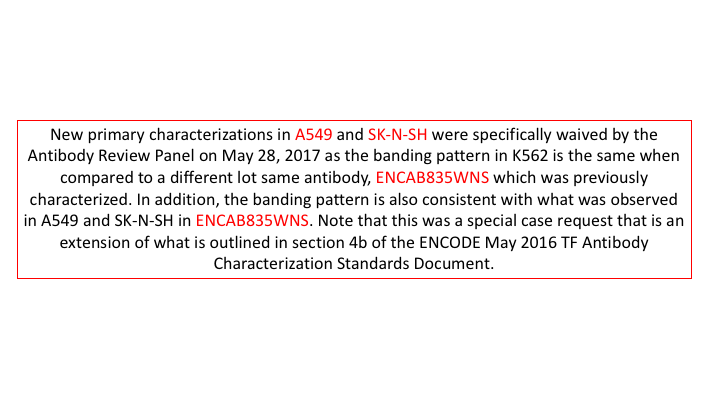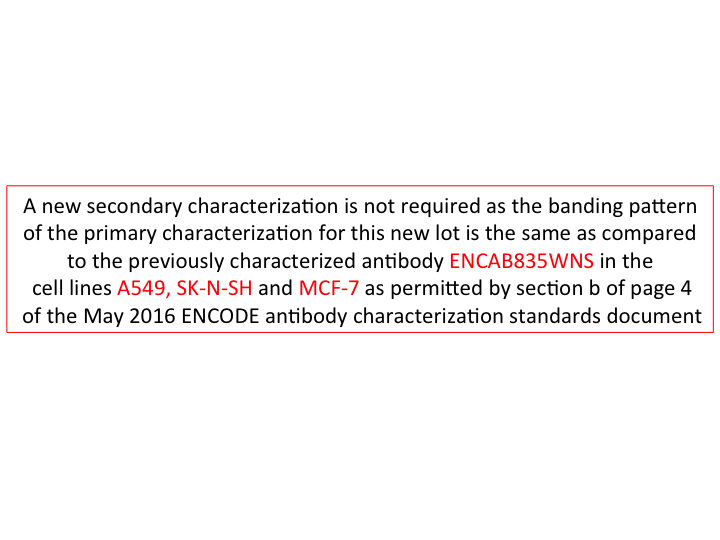ENCAB000AFK
Antibody against Homo sapiens RCOR1, Mus musculus RCOR1
Homo sapiens
K562
characterized to standards
Homo sapiens
A549, SK-N-SH
characterized to standards with exemption
Mus musculus
any cell type or tissue
partially characterized
- Status
- released
- Source (vendor)
- Santa Cruz Biotech
- Product ID
- sc-30189
- Lot ID
- C0806
- Characterized targets
- RCOR1 (Homo sapiens), RCOR1 (Mus musculus)
- Host
- rabbit
- Clonality
- polyclonal
- Purification
- other
- Antigen description
- Epitope corresponding to amino acids 246-310 mapping within an internal region of CoREST of human origin.
- External resources
Characterizations
RCOR1 (Homo sapiens)
A549SK-N-SH
exempt from standards
- Caption
- Primary characterizations were waived for this antibody in A549 and SK-N-SH on the basis of previous compliant primary and secondary characterizations in a different lot of this antibody (ENCAB835WNS).
- Submitter comment
- We ran out of this antibody lot and cannot perform characterizations in A549, IMR-90 and SK-N-SH but we have used a different lot of the same antibody to perform compliant characterizations (ENCAB835WNS).
- Reviewer comment
- The exemption request was granted by the Antibody Review Panel on May 28, 2017.
- Submitted by
- Jessika Adrian
- Lab
- Michael Snyder, Stanford
- Grant
- U54HG006996
- Download
- ENCAB000AFK_A549_SKNSH_primary.png
RCOR1 (Homo sapiens)
compliant
- Caption
- This is a new lot of a previously characterized antibody (ENCAB835WNS). New primary characterizations were done in the same cell types (MCF-7, SK-N-SH and A549) as in the old lot and also in K562. A new secondary characterization should not be needed if the banding pattern is the same in K562 and both the primary and secondary characterizations for ENCAB835WNS are compliant in K562.
- Submitter comment
- We ran out of this antibody lot and could not do a secondary characterization, but there is a new lot of the same antibody we fully characterized (ENCAB835WNS) we'd like to use to request an exemption for this lot.
- Submitted by
- Jessika Adrian
- Lab
- Michael Snyder, Stanford
- Grant
- U54HG006996
- Download
- ENCAB000AFK_secondary.png
RCOR1 (Homo sapiens)
Method: ChIP-seq comparison
not reviewed
- Caption
- Because the overlap of the top 40% of peaks from datasets derived from antibodies sc30189 and ab24166 (compared using standard ENCODE scoring methods) exceeds the recommended threshold of 80%, both antibodies meet this criterion for validation.
- Submitted by
- Michael Snyder
- Lab
- Michael Snyder, Stanford
- Grant
- U54HG004558
RCOR1 (Homo sapiens)
K562
Method: immunoprecipitation
compliant
- Caption
- We observe a single band in Western blots on cell lines K562, HeLa S3, and HepG2 that migrates slightly slower than the predicted size (~53kD) would suggest. This has been previously observed (see product literature for this and other commercial antibodies, as well as the Western blot assays in our characterization document for ab24166 against COREST). This band, but not the observed weaker bands, is specifically immunoprecipitated by sc-30189. Based on this, sc-30189 is validated by this criterion.
- Submitter comment
- This was an old characterization from ENCODE2 for an antibody we'd like to use in ENCODE3, could panel B be reviewed please?
- Submitted by
- Michael Snyder
- Lab
- Michael Snyder, Stanford
- Grant
- U54HG004558
RCOR1 (Mus musculus)
Method: ChIP-seq comparison
not reviewed
- Caption
- Comment:This antibody has been validated by ChIPSeq with two independent antibodies in human K562 cells. Please see the validation document for this antibody in human cell lines for details.
- Submitted by
- Michael Snyder
- Lab
- Michael Snyder, Stanford
- Grant
- RC2HG005602
RCOR1 (Mus musculus)
Method: immunoprecipitation
not reviewed
- Caption
- The immunogen used to generate this antibody is 92% identical in mouse and human and the proteins share 92% identity over their full lengths. We observe one major band consistent with the expected size of COREST (52kD) that is specifically immunoprecipitated by sc30189 from nuclear lysates of murine MEL cells. Additional bands observed in immunoblots using MEL nuclear lysate are not efficiently immunoprecipitated. Similar results are obtained in CH12 cells, although the immunoblot signal is weaker. A main band of similar mobility is observed in human cell lines GM12878, HeLaS3, HepG2, and K562 and this band is efficiently immunoprecipitated (see validation document for human cell lines). ChIPSeq with an independent antibody was used to validate sc30189 in human K562 cells. In combination with the previously submitted data, sc30189 meets the ENCODE criteria for validation in murine cell lines CH12 and MEL.
- Submitted by
- Michael Snyder
- Lab
- Michael Snyder, Stanford
- Grant
- RC2HG005602

